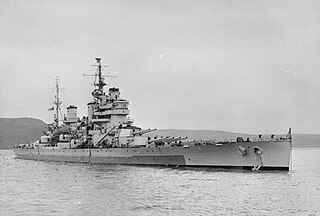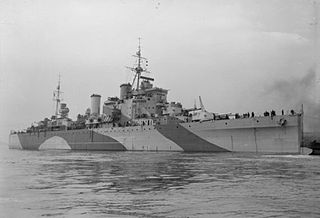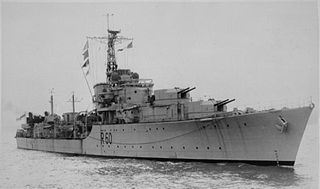
HMS Invincible was the Royal Navy's lead ship of her class of three light aircraft carriers. She was launched on 3 May 1977 as the seventh ship to carry the name. She was originally designated as an anti-submarine warfare carrier, but was used as an aircraft carrier during the Falklands War, when she was deployed with HMS Hermes. She took over as flagship of the British fleet when Hermes was sold to India. Invincible was also deployed in the Yugoslav Wars and the Second Gulf War. In 2005, she was decommissioned, and was eventually sold for scrap in February 2011.

The Fiji-class cruisers were a class of cruisers of the Royal Navy named after colonies of the British Empire. The last three were built to a slightly modified design and were also called the Ceylon class. The class was also unofficially known as the Crown Colony-class cruisers or Colony-class cruisers though unrelated to the Colony-class frigates).

HMS Anson was a King George V-class battleship of the Royal Navy, named after Admiral George Anson. She was built by Swan Hunter and Wigham Richardson Shipyard and launched on 24 February 1940, being completed on 22 June 1942. Her completion was delayed to allow the fitting of fire-control radar and additional anti-aircraft weapons. She was originally to have been named Jellicoe, but was renamed Anson in February 1940.

HMS Royal Sovereign was a Revenge-class battleship of the Royal Navy displacing 29,970 long tons (30,450 t) and armed with eight 15-inch (381 mm) guns in four twin-gun turrets. She was laid down in January 1914 and launched in April 1915; she was completed in May 1916, but was not ready for service in time to participate in the Battle of Jutland at the end of the month. She served with the Grand Fleet for the remainder of the First World War, but did not see action. In the early 1930s, she was assigned to the Mediterranean Fleet and based in Malta.

HMS London, pennant number C69, was a member of the second group of the County-class heavy cruisers of the Royal Navy. She and her sisters; Sussex, Shropshire, and Devonshire differed from the earlier group of Counties,, by having a smaller forward superstructure, which was positioned slightly further aft, and little armour plating. HMS London's career spanned over twenty years.

HMS Amazon was the first Type 21 frigate of the Royal Navy. Her keel was laid down at the Vosper Thornycroft shipyard in Southampton, England. The ship suffered a fire in the Far East in 1977, drawing attention to the risk of building warships with aluminium superstructure.

HMS Fife was the first unit of the Batch 2 County-class destroyers of the Royal Navy. She was subsequently sold to Chile and scrapped in 2005.

HMS Glamorgan was a County-class destroyer of the Royal Navy with a displacement of 5,440 tonnes. The ship was built by Vickers-Armstrongs in Newcastle Upon Tyne and named after the Welsh county of Glamorgan.
HMS Leeds Castle (P258) was a Castle-class patrol ship built by Hall, Russell & Company of Aberdeen, Scotland for the Royal Navy. She was launched in October 1980 and commissioned the following August. She was involved in the 1982 Falklands War, operating between the British territories of Ascension Island, South Georgia, and the Falkland Islands as a dispatch vessel commanded by Lieutenant-Commander Colin Hamilton.

HMS Danae was a Leander-class frigate of the Royal Navy. She was, like the rest of the class, named after a figure of mythology. Danae was built by Devonport Dockyard. She was launched on 31 October 1965 and commissioned on 10 October 1967.

HMS Vanguard was a British fast battleship built during the Second World War and commissioned afterwards. She was the biggest and fastest of the Royal Navy's battleships, the only ship of her class, and the last battleship to be built.

HMS Sluys was a Battle-class destroyer of the Royal Navy (RN). She was named in honour of the Battle of Sluys which occurred in 1340 during the Hundred Years' War, and which resulted in a decisive English victory over a French fleet. Sluys was built by Cammell Laird of Birkenhead. She was launched on 28 February 1945 and commissioned on 30 September 1946. In 1967, the ship was transferred to Iran and renamed Artemiz. In 1985, the ship was renamed again, this time Damavand.

HMS Diana was one of the Daring class of destroyers planned during the Second World War by the Royal Navy. The design reflected developments of the Pacific campaign, including long range and the ability to efficiently Replenish At Sea (RAS).

BAPAlmirante Grau(CLM-81) is a De Zeven Provinciën-class cruiser that served in the Royal Netherlands and Peruvian navies. Completed for the Dutch in 1953 as HNLMS ''De Ruyter'' (C801), she was acquired by Peru in 1973 and served as fleet flagship. Almirante Grau underwent a major modernization program between 1985 and 1988 during which she was fitted with new weapons and electronics. She was the last gun cruiser in service in any navy before being decommissioned on 26 September 2017. In 2019, it was announced that she would be preserved as a museum ship.

BAPFerré(DM-74) was a Daring-class destroyer in service with the Peruvian Navy from 1973 to 2007. She was built by Yarrow Shipbuilders and completed for the Royal Navy in 1953 as HMS Decoy (D106).

HMS Wessex was one of eight W-class destroyers built for the Royal Navy during World War II. Completed in 1944, the ship spent most of the war assigned to the Eastern and Pacific Fleets. She screened British aircraft carriers as their aircraft attacked targets in the Japanese-occupied Nicobar Islands, the Dutch East Indies and Okinawa.

Giuseppe Garibaldi was an Italian Duca degli Abruzzi-class light cruiser, that served in the Regia Marina during World War II. After the war she was retained by the Marina Militare and upgraded. She was built by CRDA, in Stabilimento Tecnico Triestino shipyard Trieste and named after the Italian general Giuseppe Garibaldi.
HMS Iveston was a Ton-class minesweeper of the Royal Navy launched on 1 June 1954 by Philip and Son in Dartmouth. After her decommissioning in 1992, HMS Iveston became the Sea Cadet training ship T.S. Iveston. She was sold and scrapped in March 2015.
HMS Stubbington was a Ton-class minesweeper which saw service with the Royal Navy during the Cold War. Built by Camper & Nicholson, Portsmouth, she was launched on 8 August 1956. She served as a minesweeper in the Mediterranean and the Middle East in the 1950s and 1960s, and in the Royal Navy Reserve under the name HMS Montrose from 1972 to 1976. She then was used for Fishery Protection duties. Stubbington was broken up in 1989.

HNLMS Tjerk Hiddes (F804) was a frigate of the Van Speijk class. The ship was in service with the Royal Netherlands Navy from 1967 to 1986. The frigate was named after Dutch naval hero Tjerk Hiddes de Vries. The ship's radio call sign was "PAVC". She was sold to the Indonesian Navy where the ship was renamed KRI Ahmad Yani (351).

















